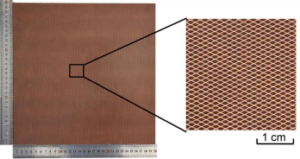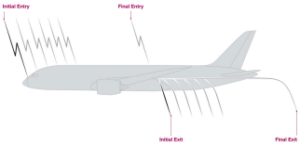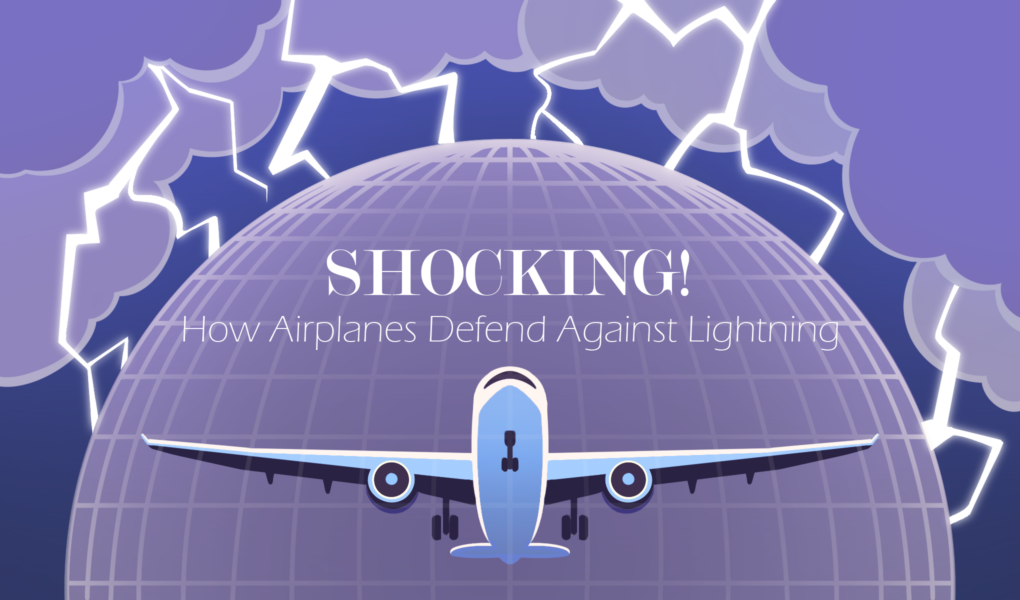Keywords
Airplane, Lightning Protection, Faraday Cage, Materials Engineering, Conduction, Weather
Abstract
When aircraft manufacturers began to transition from using metals to using composite materials, a new and significant flaw emerged in their designs – a deadly weakness to lightning. A series of passenger plane crashes resulted in the engineering of lightning strike protection (LSP) technologies, poised to protect critical components of sky-faring machinery from electrical damage. LSP designs utilize the concept of the Faraday cage, distributing charges across an aircraft’s entire surface more quickly than electricity can convert to heat. The best designs can reduce damage by nearly a thousand-fold compared to unprotected composite aircraft, keeping more flights safely in the air. The incorporation of anisotropy in LSP designs allows for additional, directional control of electron flow. Altogether, these lightning strike protection materials protect tens of thousands of aircraft each year as they traverse the troposphere.
Setting the Scene
You are relaxing on your flight home after a well-deserved vacation when the peaceful skies begin to gray. As the sun grows dimmer, blocked out by thick clouds, your view of the ocean from 37,000 ft up disappears as well. You think nothing of it until you see a bright streak of electricity split the sky in the distance. The next flash is closer. Then finally, the steady hum of your plane’s turbines is interrupted by the ear-piercing crack of a lightning bolt striking the engine just outside your window. You think the worst when you look outside to check the damage, but to your surprise, all that you can see is a slight burn mark on the exterior paint. How could such an intricate machine survive being struck by one of nature’s most powerful forces? Unbeknownst to you, brilliant minds had been developing aircraft lightning defense technologies for decades prior to protect against such forces from above. Many lightning-struck voyages before yours were not bound to the same pleasant ending – others, such as Pan Am Flight 214, had faced a grim fate before the necessity for this technology was brought to light[].
To illustrate, in 1963, residents of Elkton, Maryland, watched as a Boeing 707 flying over them was struck by a bolt of lightning. Seconds later, the aircraft exploded and crashed to the ground, leaving no survivors [1]. This was the twelfth time this happened over the span of the previous 23 years, but incidents had recently become more common, as newly manufactured carbon composite aircraft were exhibiting a severe weakness to electricity compared to their all-metal predecessors [2] [3]. To prevent further crashes and save lives in the future, aircraft manufacturers pledged to develop a technology that could enable planes to defend against lightning while in flight. Borrowing a page from Michael Faraday, scientists and engineers worked together to create a flying Faraday cage that could stand up to even the most
powerful strikes of lightning. Today, modern versions of this technology protect more than 27,000 planes as they carry billions of passengers on over 30 million commercial flights each year [4].
Origins of Aircraft Lightning Protection
In the aeronautics industry, there’s an ever-growing movement to make aircraft lighter and more fuel-efficient. This movement began with the switch from steel and wood to aluminum in the early 1920s. In 1909, a German scientist named Alfred Wilm invented a strong yet lightweight and highly elastic aluminum alloy called duralumin, which would be the primary material of the first all-metal aircraft, the Junkers J1, developed in 1915 [3]. In 1920, a new aluminum production process called the Hall-Héroult method was developed in Norway, making anodized aluminum cheap enough to use in the mass production of airplanes [2].

Figure 1: Photograph of a Junkers J1 [5]
Aluminum, steel, and sometimes titanium remained the industry standard until the implementation of carbon fiber composites as aircraft materials through the 1960s [6]. By using glass fiber-reinforced plastic as a building material, aircraft manufacturers could build considerably lighter and stronger planes at a lower cost. Additionally, these materials allowed
for improved radar stealth and for streamlined body shapes that could not be reasonably achieved with metal or wood.
With fiber-reinforced composites also came a significant disadvantage: a weakness to lightning. The high conductivity of previous generations’ metallic aircraft allowed airplanes to easily withstand most lightning strikes, as the aircraft’s outer shell would quickly divert a lightning current away from the strike area. This phenomena minimizes the temperature from rising and prevents aircraft damage aside from small burn marks, often measuring a diameter of only a few inches [7]. However, because fiber composite materials have roughly 1000 times lower conductivities than metals, composite aircrafts will experience immediate and substantial temperature rises in the area where the lightning struck.
With up to 1 million volts (30,000 amps) being concentrated into one area all at once, lightning strikes can cause breakage of composite fibers, deterioration of epoxy resins, and delamination of material layers, all of which can ultimately lead to complete aircraft material failure while in flight [8]. This has occurred several times in history; one example is the crash of Pan Am Flight 214 in 1963, which was caused when lightning destroyed the tip of the Boeing 707’s wing[]. Apollo 12 was also struck twice during its launch sequence in 1965 [9] [10].
Although lightning strikes are relatively rare, they occur enough to be a considerable problem for civilian and military aircraft alike. NASA’s world lightning map shows that the air above most landmass experiences between 1 and 70 observed lightning strikes per square kilometer each year, with warm areas closer to the equator having the highest strike concentrations (as shown in Figure 2).

Figure 2: Map of lightning observations per kilometer per year [10]
Seeing that there are more than 30 million commercial flights each year makes it nearly impossible for lightning to not hit a plane occasionally [11]. The US National Weather Service claims that almost every commercial passenger plane is struck 1-2 times each year [12]. To remediate this new issue with composite materials and reduce the risk of flying composite aircraft, materials scientists and aeronautical engineers developed solutions to emulate the conductivity of metals while retaining the weight and cost benefits of composites.
The Faraday Cage
The solution to aircraft lightning strike protection (LSP) is the Faraday cage, invented much earlier by Michael Faraday in 1836. A Faraday cage is a cage of conductive material (usually metal) that is used to protect whatever it contains from electromagnetic fields. The cage can protect the objects within it by distributing electric charge through the cage material faster than the charge can pass through the cage’s openings, creating a predetermined path of least resistance for an electric shock [13]. You may have seen an example of a Faraday cage protecting people from being shocked by Tesla coils, as shown in Figure 3. In this photograph, the cage draws and distributes the electrical current far more rapidly than it can pass through the bars, effectively protecting the child inside.

Figure 3: Faraday cage and Tesla coil [14]
Scientists and engineers took this concept and developed the first airplane lightning protection: a copper wire mesh. These meshes, which were originally manufactured by weaving copper wire (now typically made from expanded metal foils), are secured around the exterior surfaces of aircraft, just under the paint and weather-resistant coating layers [15]. This addition effectively creates a Faraday cage around the entire plane.

Figure 4: Example of a lightning strike protective copper mesh [16]
Effectiveness of Lightning Strike Protection (LSP) Technology
The first main goal of LSP is simply to minimize damage to the location of a lightning strike on a plane. As mentioned, the Faraday cage-like metal mesh does this by distributing the current throughout the entire plane’s surface and preventing Joule heating (the heating that occurs due to electrical current flowing through a material with electrical resistance) by decreasing the electrical resistance per volume of the plane’s exterior. Figure 5 shows lightning strike test results of carbon composite samples with and without copper mesh protection. Because the degree of Joule heating is directly proportional to electrical resistance, the unprotected composite material (which can be more than 1000 times more resistive) experiences severe damage, while the protected composite material only exhibits some minor surface burns.

Figure 5: Lightning strike test results showing carbon composite samples with and without copper mesh [17]
The second main goal of LSP, aside from protecting the aircraft as a whole, is to redirect a lightning strike away from critical components of the aircraft such as the cockpit, engines, electrical components, and fuel tank. Therefore, LSP technology needs to be designed to draw current away from these areas, despite the challenge. Due to the high surface curvature of an aircraft’s extremities (the cockpit, wing tips, tail wing tips, and engine nacelles), frictional charging causes electric polarization of these areas of the plane, meaning that a negatively charged lightning bolt is more likely to strike these regions of the plane, especially the cockpit. This is shown in Figure 6. To better understand this image, picture yourself taking a cross-country flight in a 737. You’re sitting in row 18, about halfway back in the plane. As you fly through a cloud, an electrostatic charge starts building up near the cockpit, the tips of the tail, and the other major extremities, as the exposed curvature of these areas build up the most static. Because the very front of the plane has the most noticeable charge difference with its surroundings, lightning is far more likely to strike the plane’s nose than to strike where you are sitting.

Figure 6: 2-dimensional electrostatic field of an aircraft in a 100 kV/m ambient field [18]
Usually, the bolt will strike from above, pass through the plane, and exit through the plane’s underside. The lightning will then continue towards the ground, which generally has a positive charge during a thunderstorm [19]. Figure 7 depicts this process.

Figure 7: Schematic showing lightning entrance and exit locations on an aircraft [10]
If lightning seems to prefer to strike critical areas of our aircraft, how can LSPs be designed to draw current away from these regions first? Aside from just adding more material
around critical areas, some aircraft ingeniously incorporate a structural material property within their LSP designs called “anisotropy”, or the property of being directionally dependent. By manipulating an LSP material’s geometry, orientation, microstructure, or chemical composition, experts can induce anisotropy with regard to electrical conductance, creating the ability to direct lightning around the plane along a predetermined path.
For example, copper mesh can be designed in diamond-shaped grids instead of in perfectly square grids. This causes one direction along the mesh to provide a more direct path for electrical conduction, meaning that the current must travel through less material to proceed in one direction than another. Because the resistance of a wire is proportional to its length, this means that resistance against a lightning current will be lower in one direction, drawing the flow primarily in that direction. Figure 8 illustrates how electricity flows preferentially in one direction of a diamond-shaped copper mesh. The left images show computer models of the mesh. The right image shows the resulting burn distribution after an electrical current injection.

Figure 8: Result of injecting current into diamond-shaped copper grid [7].
This effect can also be realized by increasing the cross-sectional area of the mesh wire in the direction of desired electrical flow. Unless they are protecting specific components of a
plane, anisotropic meshes are usually oriented with their most conductive direction pointing parallel to the fuselage, as this can help reduce resistive heat caused by lightning sweeping along the body of an aircraft. These properties can be additionally enhanced by careful selection of mesh materials [7] [16].
Conclusion
From Joule heating of a plane’s composite exterior to electromagnetic interference with electrical components, countless parameters are considered by scientists and engineers when designing modern versions of the Faraday cage for airplanes. Professionals from various fields of science and technology work together in harmony to develop a defense mechanism against one of the most terrifying phenomena of nature. With this in mind, the next time you take to the sky and see the clouds turn from white to gray, take a moment to appreciate those who have dedicated their lives to ensure that you are safe.
Works Cited
[1
“Accident investigation report completed and information captured,” Aviation Safety Network, ]
[Online]. Available: https://aviation-safety.net/database/record.php?id=19631208-0. [Accessed 4 October 2023].
[2
“Aluminium History,” UC 20RUSAL, 2013. [Online]. Available:
]
https://www.aluminiumleader.com/history/industry_history/. [Accessed 4 October 2023].
[3
- Poulton, “Aviation’s material evolution,” Airbus, 18 February 2017. [Online]. Available: ]
https://www.airbus.com/en/newsroom/news/2017-02-aviations-material-evolution. [Accessed 4 October 2023].
[4
“June 2022 Global Fleet Size,” Ch-Aviation, 2022. [Online]. Available: https://about.ch ]
aviation.com/blog/2022/06/30/june-2022-global-fleet-size-analysis-by-ch
aviation/#:~:text=The%20total%20worldwide%20fleet%20size,over%20the%20last%20three%20mon ths.. [Accessed 2023].
[5
- T. Jane, Jane’s All the World’s Aircraft 1919 Edition, Arco Pub, 1969.
]
[6
“A Brief History of Aircraft Materials,” Thomas Insights, 12 November 2019. [Online]. Available: ]
https://www.thomasnet.com/insights/a-brief-history-of-aircraft-materials/. [Accessed 4 October 2023].
[7
- Bigand, “Damage assessment on aircraft composite structure due to lightning constraints,” PhD ]
Thesis – Universite Federale Toulouse Midi-Pyrenees, pp. 1-284, 2020.
[8
- Gagne and D. Therriault, “Lightning strike protection of composites,” Progress in Aerospace ]
Sciences, vol. 64, pp. 1-16, 2024.
[9
“The History of Aircraft Lightning Protection Technology,” Weather Guard Lightning Tech, 28 March ]
- [Online]. Available: https://weatherguardaero.com/lightning-protection-technology-aircraft/. [Accessed 4 October 2023].
[1
- Sweers, B. Birch and J. Gokcen, “Lightning Strikes: Protection, Inspection, and Repair,” Boeing, 0]
- [Online]. Available: https://www.boeing.com/commercial/aeromagazine/articles/2012_q4/4/. [Accessed 4 October 2023].
[1
“Number of flights performed by the global airline industry from 2004 to 2021, with forecasts until 1]
2023,” Statista, 29 August 2023. [Online]. Available:
https://www.statista.com/statistics/564769/airline-industry-number-of-flights/. [Accessed 4 October 2023].
[1 “Lightning and Planes,” National Weather Service, [Online]. Available: https://www.weather.gov/safety/lightning-
2] planes#:~:text=Commercial%20transport%20passenger%20planes%20are,strike%20and%20conduct %20the%20currents. [Accessed 4 October 2023].
[1
- Pollette and N. Chandler, “How Faraday Cages Work,” howstuffworks, 2 September 2022. [Online]. 3]
Available: https://science.howstuffworks.com/faraday-cage.htm. [Accessed 4 October 2023]. [1
“Faraday Cage,” ScienceFacts, 2 February 2023. [Online]. Available:
4]
https://www.sciencefacts.net/faraday-cage.html. [Accessed 4 October 2023].
[1
- Katunin, K. Krukiewicz, A. Herega and G. Catalanotti, “Concept of a Conducting Composite Material 5]
for Lightning Strike Protection,” Advances in Materials Science, vol. 16, no. 2, pp. 32-46, 2016. [1
- Guo, Y. Xu, Q. Wang, Q. Dong, X. Yi and Y. Jia, “Enhanced lightning strike protection of carbon fiber 6]
composites using expanded foils with anisotropic electrical conductivity,” Composites Part A: Applied Science and Manufacturing, vol. 117, pp. 211-218, 2019.
[1
- Tyrrell, “Lightning lab to offer full waveform testing by end 2014,” Translational Materials Research, 7]
18 September 2014. [Online]. Available: http://tmrplus.iop.org/2014/09/18/lightning-lab-to-offer full-waveform-testing-by-end-2014/. [Accessed 4 October 2023].
[1
- Karch and C. Metzner, “Lightning protection of carbon fibre reinforced plastics — An overview,” 8]
2016 33rd International Conference on Lightning Protection (ICLP), 2016.
[1
“Severe Weather 101 – Lightning,” National Severe Storms Laboratory, [Online]. Available: 9]
https://www.nssl.noaa.gov/education/svrwx101/lightning/faq/#:~:text=Lightning%20from%20thund erstorms%20begins%20in,of%20the%20regions%20is%20much. [Accessed 4 October 2023].


